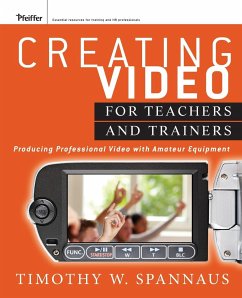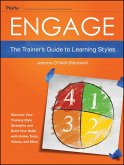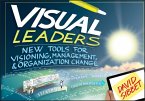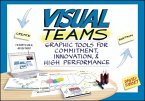Tim Spannaus
Creating Video for Teachers an
Schade – dieser Artikel ist leider ausverkauft. Sobald wir wissen, ob und wann der Artikel wieder verfügbar ist, informieren wir Sie an dieser Stelle.
Tim Spannaus
Creating Video for Teachers an
- Gebundenes Buch
- Merkliste
- Auf die Merkliste
- Bewerten Bewerten
- Teilen
- Produkt teilen
- Produkterinnerung
- Produkterinnerung
Incorporating advice from message design and multimedia research, this practical guide helps trainers plan, produce, edit, and distribute compelling, professional video, using inexpensive or free consumer-grade equipment and software. Paralleling the work process a teacher or trainer would follow, the guide shows how to "tell a story" that will engage an audience and enables trainers to create instructional videos for a wide variety of uses and traditional and digital media.
Andere Kunden interessierten sich auch für
![Appreciative Inquiry Collab Solutions Appreciative Inquiry Collab Solutions]() Robyn Stratton-BerkesselAppreciative Inquiry Collab Solutions87,99 €
Robyn Stratton-BerkesselAppreciative Inquiry Collab Solutions87,99 €![Fearless Facilitation Fearless Facilitation]() Cyndi MaxeyFearless Facilitation47,99 €
Cyndi MaxeyFearless Facilitation47,99 €![Engage Engage]() Jeanine O'Neill-BlackwellEngage63,99 €
Jeanine O'Neill-BlackwellEngage63,99 €![Visual Leaders Visual Leaders]() David SibbetVisual Leaders36,99 €
David SibbetVisual Leaders36,99 €![Visual Teams Visual Teams]() David SibbetVisual Teams30,99 €
David SibbetVisual Teams30,99 €![The Pin Drop Principle The Pin Drop Principle]() David LewisThe Pin Drop Principle23,99 €
David LewisThe Pin Drop Principle23,99 €![Leadership Leadership]() Art PadillaLeadership219,99 €
Art PadillaLeadership219,99 €-
-
Incorporating advice from message design and multimedia research, this practical guide helps trainers plan, produce, edit, and distribute compelling, professional video, using inexpensive or free consumer-grade equipment and software. Paralleling the work process a teacher or trainer would follow, the guide shows how to "tell a story" that will engage an audience and enables trainers to create instructional videos for a wide variety of uses and traditional and digital media.
Produktdetails
- Produktdetails
- Verlag: Wiley & Sons
- 1. Auflage
- Seitenzahl: 224
- Erscheinungstermin: 22. Mai 2012
- Englisch
- Abmessung: 235mm x 191mm x 12mm
- Gewicht: 420g
- ISBN-13: 9781118088098
- ISBN-10: 1118088093
- Artikelnr.: 34447692
- Herstellerkennzeichnung
- Libri GmbH
- Europaallee 1
- 36244 Bad Hersfeld
- gpsr@libri.de
- Verlag: Wiley & Sons
- 1. Auflage
- Seitenzahl: 224
- Erscheinungstermin: 22. Mai 2012
- Englisch
- Abmessung: 235mm x 191mm x 12mm
- Gewicht: 420g
- ISBN-13: 9781118088098
- ISBN-10: 1118088093
- Artikelnr.: 34447692
- Herstellerkennzeichnung
- Libri GmbH
- Europaallee 1
- 36244 Bad Hersfeld
- gpsr@libri.de
Timothy W. Spannaus is instructional technology program coordinator and senior lecturer at Wayne State University in Detroit. He teaches classes in interactive technologies including web design, multimedia, digital video and message design. In addition he directs the Certificate in University Teaching program.
Acknowledgments xv
Introduction xvii
Section I: Planning and Managing Video Projects 1
Chapter one: why Video? Why Now? 3
Demonstration of Procedures 4
Presentation by an Expert 4
Introduction to a Case Study 4
Excerpt of a Dramatic Production 5
Show a Process 5
Virtual Tours 6
Why Video? 6
Low Cost of Equipment and Software 7
Reduced Expectations of Quality 8
Traps for the Unwary 8
Chapter Two: One Time through the Process-A 30,000-Foot View 11
Treatment 13
Media Specification 14
Prototypes 16
Script Site 17
Concurrent Work 18
Shot List 19
The Shoot 19
Edit 20
Site Construction-HTML Pages 21
Final Assembly and Test 22
Launch and Distribution 22
Chapter Three: Planning 25
Goals and Objectives 25
ID Considerations-First Principles, Solving Problems 26
Integrating Video with Other Media 29
Story and Character 31
Chapter Four: Writing the Script 35
Organization 36
Treatment 36
Format 37
Writing 39
Write in Active Voice 40
Personalize the Writing 40
Think Visually 41
Style Guide 41
Integration with Other Media 42
Script Breakdown 42
Chapter Five: Other Ways to Produce Video 45
Webcams 45
Screen Recorders 47
After Capture, You Will Want to Edit 48
Adobe Flash Animations 48
Single Frame Animations 49
Chapter Six: Managing Video Projects 51
Complexity 51
Defining the Project 52
Planning 53
Tasks/Activities 53
Roles 57
Resources 58
Adjusting the Schedule 58
Executing 60
Monitoring 60
Reporting and Controlling 62
Delivering and Closing 62
Chapter Seven: Your Assignment 1 65
Plan 65
Script 65
Section II: Essential Equipment 67
Chapter Eight: Camcorders 69
Video Formats 69
Lens 71
Sensors 74
Resolution and Size 74
Storage Media 74
Necessary Features 75
Chapter Nine: Using the Camcorder 77
Composition 77
Common Shots 78
Camera Movement 83
Zooms 84
Chapter Ten: Lights and Lighting 87
Color and Intensity 87
Basic Lighting Equipment 90
Basic Lighting Setups 94
Lighting Problems 97
Chapter Eleven: Mics and Sound 101
The Importance of Sound 101
Kinds of Mics 102
Mic Setups and Use 107
Voice-Over vs. Sync Sound 108
Chapter Twelve: Your Assignment 2 Edit in Camera 111
Plan 111
Shoot 111
Section III: Production 113
Chapter Thirteen: Selecting and Surveying Locations 115
Back to the Script 115
Location Survey 116
Shots and Camera Angles 116
Lighting and Electrical Power 117
Specific Locations: Offices 117
Specific Locations: Homes 118
Specific Locations: Factories, Shops, Warehouses, and Labs 119
Exteriors 120
Commercial and Retail Locations 121
Location Releases 121
Green Screen-Any Location, Any Time 121
Chapter Fourteen: Planning the Shoot 123
Props 123
People 126
Equipment 126
Schedules 127
Chapter Fifteen: The Day of the Shoot 133
Set Up 133
Blocking and Walkthrough 134
Camera Rehearsal 135
The Actual Shoot 136
Ambient Sound 136
Tear Down 137
Chapter Sixteen: Your Assignment 3 Plan and Shoot 139
Plan 139
Shoot 139
Section IV: Post-Production 141
Chapter Seventeen: Video Editing 143
Essential Software 143
A Simple Event Shoot 146
A Planned Instructional Video 151
Cut-Ins and Cut-Aways 152
Intercutting 152
Green Screen 153
Chapter Eighteen: Audio Editing 155
Cleaning Up Camcorder Sound 155
Voice-Over Narration 157
Sound Effects 157
Music 158
Wild Sound 158
Chapter Ninteen: Effects 161
Transitions 162
Titles 162
Chapter Twenty: Your Assignment 4 165
Edit 165
Make a DVD 165
Section V: Distribution and Use 167
Chapter Twenty One: Video on Optical Media 169
CD, DVD, Blu-Ray 169
Video on CD 170
DVDs 171
Blu-Ray 171
Making the Disc 172
Chapter Twenty Two: Video on the Web 173
Adobe Flash 174
MPEG and MPEG-4 174
HTML5 175
Development: Finer Points 177
Use of Media 177
Human Resources 178
Fine-Tuning for the User's Environment 178
Video Options 178
Chapter Twenty Three: Using Video in Your Teaching and Training 181
Stand-Alone Video 181
Problem-Centered 182
Prior Knowledge 182
Demonstration 183
Practice and Feedback 184
Integration 184
Video Story by an Expert 185
Documentation 185
Video in PowerPoint or Similar Products 185
File Formats 186
Moving to a Different Computer 186
Web Video 186
References 189
About the Author 191
Index 193
Introduction xvii
Section I: Planning and Managing Video Projects 1
Chapter one: why Video? Why Now? 3
Demonstration of Procedures 4
Presentation by an Expert 4
Introduction to a Case Study 4
Excerpt of a Dramatic Production 5
Show a Process 5
Virtual Tours 6
Why Video? 6
Low Cost of Equipment and Software 7
Reduced Expectations of Quality 8
Traps for the Unwary 8
Chapter Two: One Time through the Process-A 30,000-Foot View 11
Treatment 13
Media Specification 14
Prototypes 16
Script Site 17
Concurrent Work 18
Shot List 19
The Shoot 19
Edit 20
Site Construction-HTML Pages 21
Final Assembly and Test 22
Launch and Distribution 22
Chapter Three: Planning 25
Goals and Objectives 25
ID Considerations-First Principles, Solving Problems 26
Integrating Video with Other Media 29
Story and Character 31
Chapter Four: Writing the Script 35
Organization 36
Treatment 36
Format 37
Writing 39
Write in Active Voice 40
Personalize the Writing 40
Think Visually 41
Style Guide 41
Integration with Other Media 42
Script Breakdown 42
Chapter Five: Other Ways to Produce Video 45
Webcams 45
Screen Recorders 47
After Capture, You Will Want to Edit 48
Adobe Flash Animations 48
Single Frame Animations 49
Chapter Six: Managing Video Projects 51
Complexity 51
Defining the Project 52
Planning 53
Tasks/Activities 53
Roles 57
Resources 58
Adjusting the Schedule 58
Executing 60
Monitoring 60
Reporting and Controlling 62
Delivering and Closing 62
Chapter Seven: Your Assignment 1 65
Plan 65
Script 65
Section II: Essential Equipment 67
Chapter Eight: Camcorders 69
Video Formats 69
Lens 71
Sensors 74
Resolution and Size 74
Storage Media 74
Necessary Features 75
Chapter Nine: Using the Camcorder 77
Composition 77
Common Shots 78
Camera Movement 83
Zooms 84
Chapter Ten: Lights and Lighting 87
Color and Intensity 87
Basic Lighting Equipment 90
Basic Lighting Setups 94
Lighting Problems 97
Chapter Eleven: Mics and Sound 101
The Importance of Sound 101
Kinds of Mics 102
Mic Setups and Use 107
Voice-Over vs. Sync Sound 108
Chapter Twelve: Your Assignment 2 Edit in Camera 111
Plan 111
Shoot 111
Section III: Production 113
Chapter Thirteen: Selecting and Surveying Locations 115
Back to the Script 115
Location Survey 116
Shots and Camera Angles 116
Lighting and Electrical Power 117
Specific Locations: Offices 117
Specific Locations: Homes 118
Specific Locations: Factories, Shops, Warehouses, and Labs 119
Exteriors 120
Commercial and Retail Locations 121
Location Releases 121
Green Screen-Any Location, Any Time 121
Chapter Fourteen: Planning the Shoot 123
Props 123
People 126
Equipment 126
Schedules 127
Chapter Fifteen: The Day of the Shoot 133
Set Up 133
Blocking and Walkthrough 134
Camera Rehearsal 135
The Actual Shoot 136
Ambient Sound 136
Tear Down 137
Chapter Sixteen: Your Assignment 3 Plan and Shoot 139
Plan 139
Shoot 139
Section IV: Post-Production 141
Chapter Seventeen: Video Editing 143
Essential Software 143
A Simple Event Shoot 146
A Planned Instructional Video 151
Cut-Ins and Cut-Aways 152
Intercutting 152
Green Screen 153
Chapter Eighteen: Audio Editing 155
Cleaning Up Camcorder Sound 155
Voice-Over Narration 157
Sound Effects 157
Music 158
Wild Sound 158
Chapter Ninteen: Effects 161
Transitions 162
Titles 162
Chapter Twenty: Your Assignment 4 165
Edit 165
Make a DVD 165
Section V: Distribution and Use 167
Chapter Twenty One: Video on Optical Media 169
CD, DVD, Blu-Ray 169
Video on CD 170
DVDs 171
Blu-Ray 171
Making the Disc 172
Chapter Twenty Two: Video on the Web 173
Adobe Flash 174
MPEG and MPEG-4 174
HTML5 175
Development: Finer Points 177
Use of Media 177
Human Resources 178
Fine-Tuning for the User's Environment 178
Video Options 178
Chapter Twenty Three: Using Video in Your Teaching and Training 181
Stand-Alone Video 181
Problem-Centered 182
Prior Knowledge 182
Demonstration 183
Practice and Feedback 184
Integration 184
Video Story by an Expert 185
Documentation 185
Video in PowerPoint or Similar Products 185
File Formats 186
Moving to a Different Computer 186
Web Video 186
References 189
About the Author 191
Index 193
Acknowledgments xv
Introduction xvii
Section I: Planning and Managing Video Projects 1
Chapter one: why Video? Why Now? 3
Demonstration of Procedures 4
Presentation by an Expert 4
Introduction to a Case Study 4
Excerpt of a Dramatic Production 5
Show a Process 5
Virtual Tours 6
Why Video? 6
Low Cost of Equipment and Software 7
Reduced Expectations of Quality 8
Traps for the Unwary 8
Chapter Two: One Time through the Process-A 30,000-Foot View 11
Treatment 13
Media Specification 14
Prototypes 16
Script Site 17
Concurrent Work 18
Shot List 19
The Shoot 19
Edit 20
Site Construction-HTML Pages 21
Final Assembly and Test 22
Launch and Distribution 22
Chapter Three: Planning 25
Goals and Objectives 25
ID Considerations-First Principles, Solving Problems 26
Integrating Video with Other Media 29
Story and Character 31
Chapter Four: Writing the Script 35
Organization 36
Treatment 36
Format 37
Writing 39
Write in Active Voice 40
Personalize the Writing 40
Think Visually 41
Style Guide 41
Integration with Other Media 42
Script Breakdown 42
Chapter Five: Other Ways to Produce Video 45
Webcams 45
Screen Recorders 47
After Capture, You Will Want to Edit 48
Adobe Flash Animations 48
Single Frame Animations 49
Chapter Six: Managing Video Projects 51
Complexity 51
Defining the Project 52
Planning 53
Tasks/Activities 53
Roles 57
Resources 58
Adjusting the Schedule 58
Executing 60
Monitoring 60
Reporting and Controlling 62
Delivering and Closing 62
Chapter Seven: Your Assignment 1 65
Plan 65
Script 65
Section II: Essential Equipment 67
Chapter Eight: Camcorders 69
Video Formats 69
Lens 71
Sensors 74
Resolution and Size 74
Storage Media 74
Necessary Features 75
Chapter Nine: Using the Camcorder 77
Composition 77
Common Shots 78
Camera Movement 83
Zooms 84
Chapter Ten: Lights and Lighting 87
Color and Intensity 87
Basic Lighting Equipment 90
Basic Lighting Setups 94
Lighting Problems 97
Chapter Eleven: Mics and Sound 101
The Importance of Sound 101
Kinds of Mics 102
Mic Setups and Use 107
Voice-Over vs. Sync Sound 108
Chapter Twelve: Your Assignment 2 Edit in Camera 111
Plan 111
Shoot 111
Section III: Production 113
Chapter Thirteen: Selecting and Surveying Locations 115
Back to the Script 115
Location Survey 116
Shots and Camera Angles 116
Lighting and Electrical Power 117
Specific Locations: Offices 117
Specific Locations: Homes 118
Specific Locations: Factories, Shops, Warehouses, and Labs 119
Exteriors 120
Commercial and Retail Locations 121
Location Releases 121
Green Screen-Any Location, Any Time 121
Chapter Fourteen: Planning the Shoot 123
Props 123
People 126
Equipment 126
Schedules 127
Chapter Fifteen: The Day of the Shoot 133
Set Up 133
Blocking and Walkthrough 134
Camera Rehearsal 135
The Actual Shoot 136
Ambient Sound 136
Tear Down 137
Chapter Sixteen: Your Assignment 3 Plan and Shoot 139
Plan 139
Shoot 139
Section IV: Post-Production 141
Chapter Seventeen: Video Editing 143
Essential Software 143
A Simple Event Shoot 146
A Planned Instructional Video 151
Cut-Ins and Cut-Aways 152
Intercutting 152
Green Screen 153
Chapter Eighteen: Audio Editing 155
Cleaning Up Camcorder Sound 155
Voice-Over Narration 157
Sound Effects 157
Music 158
Wild Sound 158
Chapter Ninteen: Effects 161
Transitions 162
Titles 162
Chapter Twenty: Your Assignment 4 165
Edit 165
Make a DVD 165
Section V: Distribution and Use 167
Chapter Twenty One: Video on Optical Media 169
CD, DVD, Blu-Ray 169
Video on CD 170
DVDs 171
Blu-Ray 171
Making the Disc 172
Chapter Twenty Two: Video on the Web 173
Adobe Flash 174
MPEG and MPEG-4 174
HTML5 175
Development: Finer Points 177
Use of Media 177
Human Resources 178
Fine-Tuning for the User's Environment 178
Video Options 178
Chapter Twenty Three: Using Video in Your Teaching and Training 181
Stand-Alone Video 181
Problem-Centered 182
Prior Knowledge 182
Demonstration 183
Practice and Feedback 184
Integration 184
Video Story by an Expert 185
Documentation 185
Video in PowerPoint or Similar Products 185
File Formats 186
Moving to a Different Computer 186
Web Video 186
References 189
About the Author 191
Index 193
Introduction xvii
Section I: Planning and Managing Video Projects 1
Chapter one: why Video? Why Now? 3
Demonstration of Procedures 4
Presentation by an Expert 4
Introduction to a Case Study 4
Excerpt of a Dramatic Production 5
Show a Process 5
Virtual Tours 6
Why Video? 6
Low Cost of Equipment and Software 7
Reduced Expectations of Quality 8
Traps for the Unwary 8
Chapter Two: One Time through the Process-A 30,000-Foot View 11
Treatment 13
Media Specification 14
Prototypes 16
Script Site 17
Concurrent Work 18
Shot List 19
The Shoot 19
Edit 20
Site Construction-HTML Pages 21
Final Assembly and Test 22
Launch and Distribution 22
Chapter Three: Planning 25
Goals and Objectives 25
ID Considerations-First Principles, Solving Problems 26
Integrating Video with Other Media 29
Story and Character 31
Chapter Four: Writing the Script 35
Organization 36
Treatment 36
Format 37
Writing 39
Write in Active Voice 40
Personalize the Writing 40
Think Visually 41
Style Guide 41
Integration with Other Media 42
Script Breakdown 42
Chapter Five: Other Ways to Produce Video 45
Webcams 45
Screen Recorders 47
After Capture, You Will Want to Edit 48
Adobe Flash Animations 48
Single Frame Animations 49
Chapter Six: Managing Video Projects 51
Complexity 51
Defining the Project 52
Planning 53
Tasks/Activities 53
Roles 57
Resources 58
Adjusting the Schedule 58
Executing 60
Monitoring 60
Reporting and Controlling 62
Delivering and Closing 62
Chapter Seven: Your Assignment 1 65
Plan 65
Script 65
Section II: Essential Equipment 67
Chapter Eight: Camcorders 69
Video Formats 69
Lens 71
Sensors 74
Resolution and Size 74
Storage Media 74
Necessary Features 75
Chapter Nine: Using the Camcorder 77
Composition 77
Common Shots 78
Camera Movement 83
Zooms 84
Chapter Ten: Lights and Lighting 87
Color and Intensity 87
Basic Lighting Equipment 90
Basic Lighting Setups 94
Lighting Problems 97
Chapter Eleven: Mics and Sound 101
The Importance of Sound 101
Kinds of Mics 102
Mic Setups and Use 107
Voice-Over vs. Sync Sound 108
Chapter Twelve: Your Assignment 2 Edit in Camera 111
Plan 111
Shoot 111
Section III: Production 113
Chapter Thirteen: Selecting and Surveying Locations 115
Back to the Script 115
Location Survey 116
Shots and Camera Angles 116
Lighting and Electrical Power 117
Specific Locations: Offices 117
Specific Locations: Homes 118
Specific Locations: Factories, Shops, Warehouses, and Labs 119
Exteriors 120
Commercial and Retail Locations 121
Location Releases 121
Green Screen-Any Location, Any Time 121
Chapter Fourteen: Planning the Shoot 123
Props 123
People 126
Equipment 126
Schedules 127
Chapter Fifteen: The Day of the Shoot 133
Set Up 133
Blocking and Walkthrough 134
Camera Rehearsal 135
The Actual Shoot 136
Ambient Sound 136
Tear Down 137
Chapter Sixteen: Your Assignment 3 Plan and Shoot 139
Plan 139
Shoot 139
Section IV: Post-Production 141
Chapter Seventeen: Video Editing 143
Essential Software 143
A Simple Event Shoot 146
A Planned Instructional Video 151
Cut-Ins and Cut-Aways 152
Intercutting 152
Green Screen 153
Chapter Eighteen: Audio Editing 155
Cleaning Up Camcorder Sound 155
Voice-Over Narration 157
Sound Effects 157
Music 158
Wild Sound 158
Chapter Ninteen: Effects 161
Transitions 162
Titles 162
Chapter Twenty: Your Assignment 4 165
Edit 165
Make a DVD 165
Section V: Distribution and Use 167
Chapter Twenty One: Video on Optical Media 169
CD, DVD, Blu-Ray 169
Video on CD 170
DVDs 171
Blu-Ray 171
Making the Disc 172
Chapter Twenty Two: Video on the Web 173
Adobe Flash 174
MPEG and MPEG-4 174
HTML5 175
Development: Finer Points 177
Use of Media 177
Human Resources 178
Fine-Tuning for the User's Environment 178
Video Options 178
Chapter Twenty Three: Using Video in Your Teaching and Training 181
Stand-Alone Video 181
Problem-Centered 182
Prior Knowledge 182
Demonstration 183
Practice and Feedback 184
Integration 184
Video Story by an Expert 185
Documentation 185
Video in PowerPoint or Similar Products 185
File Formats 186
Moving to a Different Computer 186
Web Video 186
References 189
About the Author 191
Index 193








